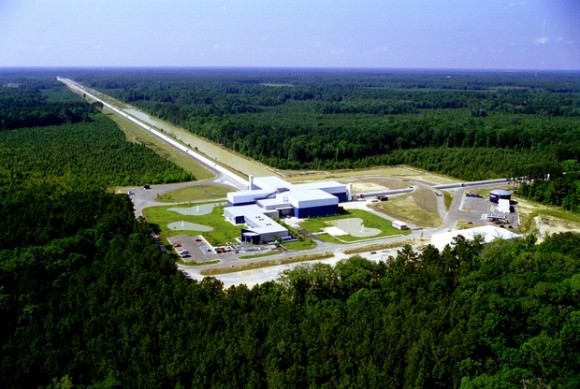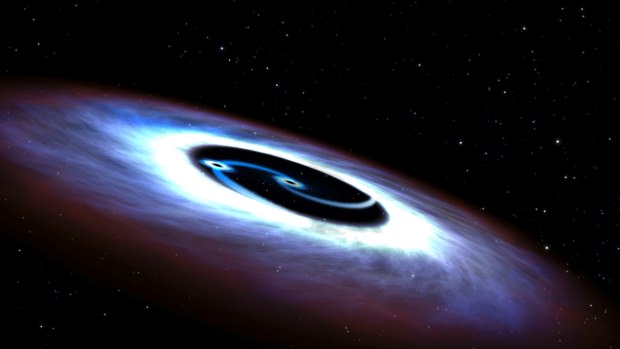“Ladies and Gentlemen, we have detected gravitational waves. We did it.”
With those words, Dave Reitze, executive director of the U.S.-based Laser Interferometry Gravitational-Wave Observatory (LIGO), has opened a new window into the universe, and ushered in a new era in space science.
Predicted over 100 years ago by Albert Einstein, gravitational waves are ripples in space-time. They travel in waves, like light does, but they aren’t radiation. They are actual perturbations in the fabric of space-time itself. The ones detected by LIGO, after over ten years of “listening”, came from a binary system of black holes over 1.3 billion light years away, called Markarian 231.
The two black holes, each 30 times as massive as the Sun, orbited each other, then spiralled together, ultimately colliding and merging together. The collision sent gravitational waves rippling through space time.
LIGO, which is actually two separate facilities separated by over 3,000 km, is a finely tuned system of lasers and sensors that can detect these tiny ripples in space-time. LIGO is so sensitive that it can detect ripples 10,000 times smaller than a proton, in laser beams 4 kilometres long.

Light is—or has been up until now—the only way to study objects in the universe. This includes everything from the Moon, all the way out to the most distant objects ever observed. Astronomers and astrophysicists use observatories that can see in not only visible light, but in all other parts of the electromagnetic spectrum, to study objects in the universe. And we’ve learned an awful lot. But things will change with this announcement.
“I think we’re opening a window on the universe,” Dave Reitze said.
Another member of the team that made this discovery, astrophysicist Szabolcs Marka from Columbia University, said, “Until this moment we had our eyes on the sky and we couldn’t hear the music.”
Gravitational waves are a new way to study notoriously difficult things to observe like black holes and neutron stars. Black holes emit no light at all, and their characteristics and properties are inferred from cause and effect relationships with objects near them. But the detection of gravitational waves holds the promise of answering questions about black holes, neutron stars, and even the early days of our universe, including the Big Bang.
It’s almost impossible to overstate the magnitude of this discovery. Once we understand how to better detect and observe gravitational waves, we may come to a whole new understanding of the universe, and we may look back on this day as truly ground-breaking and revolutionary.
And it all started 100 years ago with Albert Einstein’s prediction.
For a better understanding of Gravitational Waves, their sources, and their detection, check out Markus Possel’s excellent series of articles:
Gravitational Waves and How They Distort Space
Gravitational Wave Detectors and How They Work
Sources of Gravitational Waves: The Most Violent Events in the Universe


“Light is—or has been up until now—the only way to study objects in the universe. ”
Ummm – neutrinos?
Still I take your point.
But how about all that missing mass – transformed into energy and shot out at the speed of light in all directions. If gravity waves essentially take some measure of mass and send it out in waves…. is normal matter (and dark matter for example) evaporating?
robots with drills! 🙂
Before this discovery there were four sources of information:
*Light
*Probes directly detecting magnetic fields of Sun, Earth, planets, etc.
*Sampling of physical material. Meteorites, sample returns of Solar wind, asteroid dust, and Moon rocks
*Neutrinos
Gravitational waves makes five.
the IBEX probe watches for neutral atoms from the interstellar medium. Six.
Cosmic rays. Seven.
That header image caption can’t be right :S
The binary BH that merged is not Markarian 231.
https://en.wikipedia.org/wiki/Markarian_231
Other non-EM ways we learn of the cosmos… IBEX watch of neutral atoms… and the cosmic ray observances
Cosmic rays are energetic atomic nuclei. Is that not counting as EM?
Sure, but what we observe of them is the cascades they cause in the atmosphere, and those are detected as EM waves.
No – EM is not cosmic rays. Gamma rays yes but not cosmic rays. We detect them by EM phenomena but they are themselves matter.
Does the discovery include a figure for the speed at which these wavs propagate ie is it the speed of light or slower?
Gravitational waves propagate at the speed of light, yes.
How do we know that these gravitational waves are from Markarian 231, as opposed to an event from some other corner of the universe? How ‘directional’ is LIGO?
Definitely not M231, that caption is bonkers (fix it UT!). For one thing, M231 is a binary supermassive BH, way bigger than the 30 solar masses BH that LIGO detected. Also M231 won’t merge for billions of years yet, if at all.
LIGO is poorly directional atm, 600 square degrees were mentioned and there is an image somewhere that shows the possible area over the sky. Things will get much better when more detectors get online: European VIRGO later this year, then a Japanese machine. It should be possible to locate sources within a few square degrees then, maybe enough for scopes to search for optical counterparts.
As Manu has pointed out, it is definitely not Markarian 231 – wrong masses (by many orders of magnitude), wrong distance (by a factor of ~ 2.2) and wrong celestial hemisphere. I can’t think what Evan Gough was thinking of when he posted this nonsensical bit of information.
You can download the LIGO paper from here:
https://dcc.ligo.org/public/0122/P1500218/012/GW150914_parameter_estimation_v13.pdf
It includes the ‘sky map’ indicating the likely direction of the source of the signal, see page 8.
@B-Ark
As Manu has pointed out, it is definitely not Markarian 231 – wrong masses (by many orders of magnitude), wrong distance (by a factor of ~ 2.2) and wrong celestial hemisphere. I can’t think what Evan Gough was thinking of when he posted this nonsensical bit of information.
You can download the LIGO paper from here:
https://dcc.ligo.org/public/0122/P1500218/012/GW150914_parameter_estimation_v13.pdf
It includes the ‘sky map’ indicating the likely direction of the source of the signal, see page 8.
I’ve heard this could be a totally new field of science. I propose it should be called “Gravitygraphy”.
My take:
So, bottom line, we don’t have a clue as to what caused this particular detected event.
And, even with multiple detectors, we will need optical/radio telescopes to find the ‘likely suspect’.
@MICH48 – Too many syllables – I’d go with gravigraphy.
@ B-ARK
If you read the LIGO paper at https://dcc.ligo.org/public/0122/P1500218/012/GW150914_parameter_estimation_v13.pdf you’ll find that the authors have a very good grasp of what caused this particular event.
As for pinning it down to an optical object, that sort of detail won’t be available until there are more LIGO class instruments in operation, and of course optical telescopes will be part of the process of finding the ‘likely suspect’ – same as in the early days of radio astronomy.
I’ve read now that the gravitational signal was received shortly after turning LIGO on. Is that just serendipitous? How often are signals like this expected to be seen? Will we see both stronger and weaker signals? How close to the lower limit of detectability was the signal that was received?
That’s just a few of the questions burning in my brain. Can someone in or close to the discovery team please answer them?
They actually think there was another, smaller sighting they are still working on teasing out of the data.